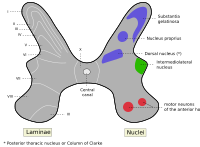
Photo from wikipedia
We report evidence that ephaptic interactions may occur between intact mammalian myelinated nerve fibres and not only between demyelinated or damaged mammalian nerve fibres or nerve cells as analysed in… Click to show full abstract
We report evidence that ephaptic interactions may occur between intact mammalian myelinated nerve fibres and not only between demyelinated or damaged mammalian nerve fibres or nerve cells as analysed in previous studies. The ephaptic interactions were investigated between nerve fibres traversing the lumbar dorsal roots and between bundles of fibres in the sciatic nerve in anaesthetized rats in vivo. The interactions were estimated by comparing the excitability of nerve fibres originating from one of the hindlimb nerves (peroneal or sural) under control conditions and when the stimulation of these fibres was combined with stimulation of another nerve (tibial). An increase in nerve volleys recorded from group I muscle afferents in the peroneal nerve and of the fastest skin afferents in the sural nerve was used as a measure of the increase in the excitability. The excitability of these fibres was increased during a fraction of a millisecond, coinciding with the period of passage of nerve impulses evoked by the conditioning stimulation of the tibial nerve. The degree of the increase was comparable to the increases in the excitability evoked by 1–2 min lasting fibre polarization. Ephaptic interactions were found to be more potent and with longer lasting after‐effects within the dorsal roots than within the sciatic nerve. We postulate that ephaptic interactions may result in the synchronization of information forwarded via neighbouring afferent nerve fibres prior to their entry into the spinal cord and thereby securing the propagation of nerve impulses across branching points within the spinal grey matter.
Journal Title: European Journal of Neuroscience
Year Published: 2019
Link to full text (if available)
Share on Social Media: Sign Up to like & get
recommendations!